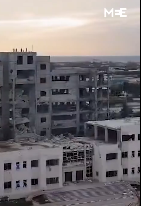Israa University, along with its under-construction medical center, has become the latest casualty of the 103-day long Israeli genocide in Gaza after every other university has already been bombed and destroyed by Israeli forces during this ongoing onslaught of every part of the Gaza Strip. This includes many historical, cultural, and educational institutions – from the oldest church in Gaza, to the oldest mosque, to the National Archives, museums, galleries and libraries. All of these have been targeted by Israeli bombardment – despite having zero connections to the Hamas political party, which Israel continues to claim is the target of its massive and ongoing bombardment.
The Israa University was detonated with 315 mines places by the Israeli military – clearly undermining any claim that there was any military threat or reason for detonating it.
The Israeli military just blew up the University of Palestine in Gaza City with 315 mines. All the universities in Gaza have been damaged or destroyed. We need a full academic boycott. pic.twitter.com/nNStUTBc9e
— Nicola Perugini (@PeruginiNic) January 17, 2024
Israa University’s official Facebook page posted: “The army occupied and used it as a military base for its operations and a centre for snatching isolated civilians … and temporarily detained them for interrogations.”
Eight universities have been targeted during the more than three months of daily bombings, which have killed an average of 100 children each day since October 7th.
On October 9th, Israeli forces bombed the Islamic University and the Al-Azhar University.
The Islamic University of Gaza issued a statement on 10 October saying: “Large parts of the buildings of the Islamic University of Gaza were subjected to major damage and severe material losses” as a result of Israeli airstrikes on Gaza City on 9 October.
“The building of the College of Information Technology, the building of the Deanship of Community Service and Continuing Education, and the building of the university’s College of Sciences were all seriously damaged,” read the statement. During the ground invasion, which began in the end of October, the rest of the Islamic University buildings were detonated by Israeli forces.
The Islamic University in Gaza….
Destroyed by the occupation army 🐷 pic.twitter.com/5Id4ldwx7r— Dr. Zain Abbadi (@ZainAbbadi11) January 10, 2024
On December 10th, Israeli forces detonated the medical school of the Islamic University.
View this post on Instagram
The attack on the medical school corresponds with the attacks on hospitals, which has resulted in every hospital in the Gaza Strip coming under attack by Israeli bombardment – killing patients, medical personnel and internally displaced refugees who sought shelter at the hospitals.
Israeli troops have also targeted prominent academics, like Professor Sufian Tayeh, who headed the largest university in Gaza.
Professor Sufian Tayeh, who headed the largest university in #Gaza, killed in an Israeli airstrike on the Jabalia refugee camp.
He was ranked among the top 2% of researchers globally & was appointed UNESCO chair for Physical & Astrophysical sciences in Palestine. pic.twitter.com/lqEvhN3Wp5
— Rami Jarrah (@RamiJarrah) December 2, 2023
University #professors, #teachers, and #educators whereever you are, join us for a day of action to denounce and mourn the brutal killing of university professors and educators by #Israel during its genocidal war in #Gaza. Print this, spread the word!#hummus#falafel pic.twitter.com/ldc6fJVPZc
— Zahra Ali زهراء علي (@ZahraSociology) January 16, 2024
195 recognized historical heritage sites have been destroyed by Israeli forces, including an ancient harbour dating back to 800 BC, a mosque that was home to rare manuscripts and one of the world’s oldest Christian monasteries. are just a few of at least 195 heritage sites that have been destroyed or damaged since Israel’s war on Gaza began on October 7, according to an NGO documenting war damage on cultural sites.
Al Jazeera wrote in December about this cultural genocide: “Gaza, one of the world’s longest inhabited areas, has been home to a pastiche of people since at least the 15th century BC, according to historians.
“Empires – including the ancient Egyptians, Assyrians and Romans – have come and gone, at times dominating the land of the Canaanites, the ancestors of the Palestinians, leaving relics of their own cultural heritage behind. Greeks, Jews, Persians and Nabateans have also lived along this stretch of coast over the centuries.
“Strategically located on the Mediterranean’s eastern shores, Gaza was always in a prime position on the trade routes from Eurasia to Africa. Its ports made it a regional hub for commerce and culture. Since at least 1300 BC, the Via Maris – a route running from Heliopolis in ancient Egypt, cutting across Gaza’s western coastline and then crossing into Syrian lands – was the main route that travellers would take on their journeys to Damascus.
“The crime of targeting and destroying archaeological sites should spur the world and UNESCO into action to preserve this great civilisational and cultural heritage,” Gaza’s Ministry of Tourism and Antiquities said after Gaza’s Great Omari Mosque was destroyed in an Israeli air strike on December 8.”

